This was one of the most challenging things I have ever done in my life, but so rewarding and worth it at the same time.
Leave a comment below if you enjoyed the read.
Preparation
Contents
I got my Honda XR650R only a few weeks before the trip. Although from 2001, the piece I got was in a really good condition. You cannot ever know for sure, but the guy who sold it to me told me that the bike was stand still on a parking for most of its life and it had only 3k km on the clock. It is hard to believe this is original milage given the bike is 23 years old, but overall mechanically and visually it all looked ok.
Since I got it shortly before the trip there was little time to get used to it, but I managed to ride with it a few times in Wahiba Sands.

Based on my earlier experience of destroying the engine of my friend’s XR650R just a few weeks back, I did two modifications to the bike before the Empty Quarter trip:
- Add a cooler fan on the radiator
- Seal the metal strainer on the air filter with silicone
I learned that XR’s tend to boil the coolant on slower speeds with higher rpms. Not sure if this affects the engine, but following the advise of the internet I added a cooling fan with a simple ON/OFF switch as I knew Empty Quarter is going to be hot. I am still not sure of the impact of adding this fan as the space between the radiator and the tank is pretty tight so the hot air sucked out from the radiator by the fan may bounce back from the tank and be circulated around the radiator rather than removed from it making it the opposite effect. Still testing this.

The air to the carburettor passes a foam like filter and a metal strainer (or cleaner like Honda calls them) before entering the cylinder. The metal strainer sits tight, however there are number of gaps between it and the plastic housing (it can be forgiven that some plastic deformed after two decades) so I sealed it around with silicone – the risk of sand ingress to the cylinder and damage the engine was too high.

This is exactly what happened with my friends’ XR that sucked in sand through the air intake and damaged the top part of the engine. At the time it happened the throttle got stuck at full rpm and we thought simply cleaning the carburettor would fix the problem so we tried.

Unfortunately, the engine lost compression and we knew this was serious, so after 2 hours of trying we gave up and had to tow the bike down on the trunk of a Land Cruiser from the dunes some 20 km back to the trailer.

So with this experience I wanted to do all I could to make sure no single grain of sand enters the carburettor. It turned out that sand still got in, but it did not damage the bike – more about this later.
When it comes to other preparations Yousuf and his team covered number of contingencies. They took all it was needed to feed (full board) nine people for six days including two barrels of fuel, spares parts for the bikes and camping stuff. Not only that – going to places so remote like Empty Quarter you also need to plan for the unknown – so a few days back they went and hid water, fuel and a spare bike somewhere in the desert just in case.
The Team
We all met in Ubar on Day 1 with aim to depart shortly after lunch. The group was made of 7 bike riders (led by Franco Picco – more about him later) with two cars driven by Yousuf and Mathias. From the left Mauro, Vittorio, Enrico, Guido, Mario, Franco and me.

The overall leader of the group was Yousuf who does these trips back to back from November to February. I am sure you can get used to it, but still doing it as your normal job is pretty hard. Here is his contact details in case interested in joining the Empty Quarter trip: https://www.instagram.com/oman_empty_quarter_tours



The Route
In total, we did 616 km off-road over 6 days from and returning to Ubar. Route details and GPX files are available below.

Below a few highlights about the route itself. Shortly after Ubar we entered vast plains, which were pretty easy, only occasionally with some sandy pockets and rocks here and there – it was a very good warm up.

Afterwards we entered the Wadi area – or dry river like they call it. What is interesting is that unlike most of other wadis in Oman this Wadi flows inland rather than towards the sea. It is clear from the topography map why:

You would not tell that you are entering a wadi, but we certainly had more bushes and overall greenery.


Some 20km down the line we started to see first dunes – very different and much bigger than the Wahiba sands.



Once we entered more inland the dunes were much bigger, however they were separated with nice flat plains. That is the beauty of the Empty Quarter: you work out on the dunes and then cool off on longer straights before doing another one – it is a really nice mix.

Leaving a dune that gave so much fun was sometimes difficult 🙂











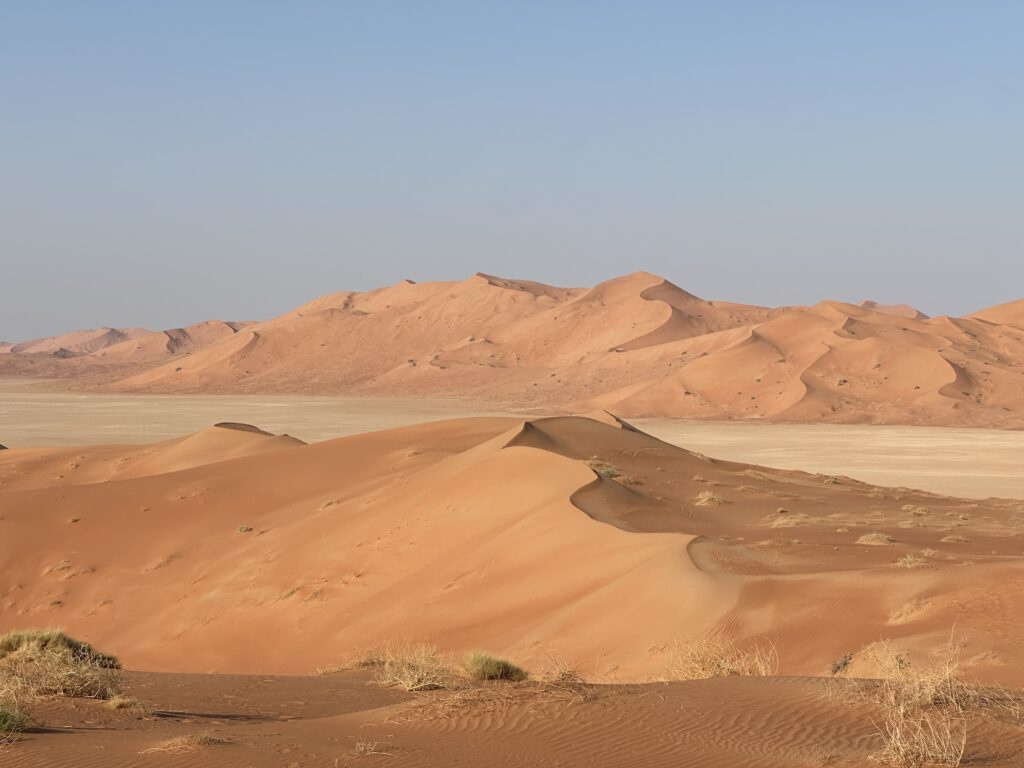



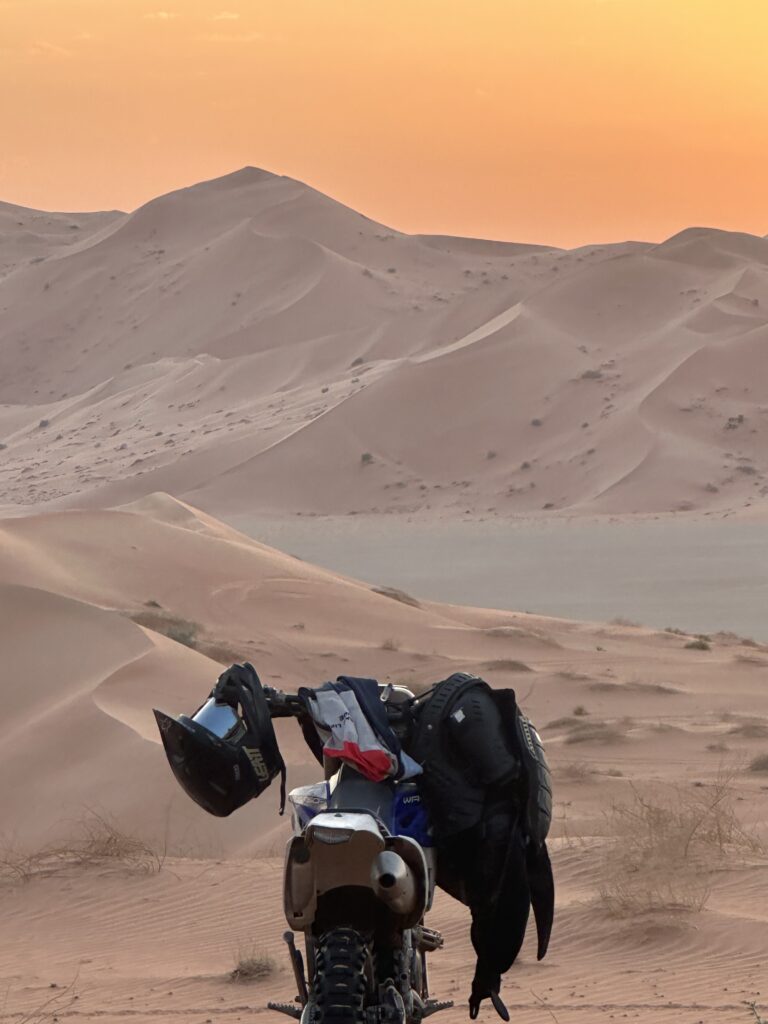
The Lost City of Ubar
For those unfamiliar with Ubar start here: https://madainproject.com/ubar (link doesn’t work with VPN)
Whether the fort of Ubar (وبار) also spelled Wubar, modern day Shisr (الشصر) was lost and then rediscovered I am still trying to figure that out. The two folks that claim to have (re)discovered it, Ranulph Fiennes and Nicholas Clapp, using satellite images, and published books about it in 1992 and 1998 respectively are doubtful to me because Wilfred Thesiger, some 40 years earlier, in his 1959 book (highly recommended read by the way) describes Shishsur in exactly the same way I saw Ubar today:
We watered as Shishur, where the ruins of a crude stone fort on a rocky mound mark the position of this famous well, the only permanent water in the central steppes. Shishur was a necessary watering-place for raiders and had been the scene of many fierce fights. A the bottom of the large cave which undercuts the mound there was a trickle of water in a deep fissure. This water could only be reached with difficulty down a narrow passage between the rock wall and a bank of sand thirty feet in height, which half filled the cave.
Arabian Sands by Wilfred Thesiger (Chapter 5, 105)
Looking at Wilfred 1959 maps you could also see the location of Shishur matches the one of Ubar.
I guess anyone who see it discovers it in their own way. For me Ubar was about the ancient connection of giving life now and then. Those needing to water the last time before entering the desert relied on it then and also today surrounded by crops (see below), albeit in a different form, it continuous to give life to others.



Before reaching Ubar it was interesting the to see the area was full of agriculture with circle shaped farms.
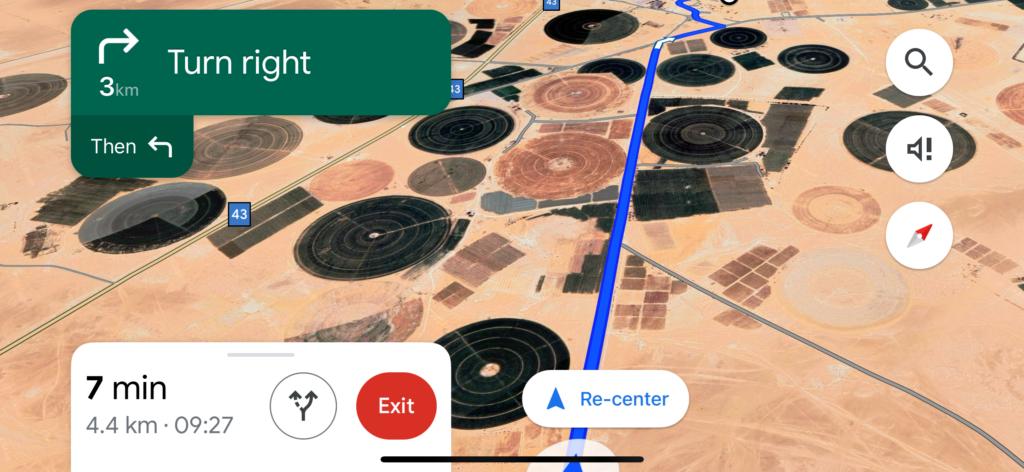

Along the vein of Nicholas Clapp’s “The Road To Ubar: Finding the Atlantis of the Sands” my road to Ubar was adventurous too. I wanted to make a short cut and took one of the offroad roads – but unfortunately it was so bumpy that I destroyed the mud cover on the trailer (bolts unscrewing due to vibration) and had to return after some 20 km in.


The 3 challenges
Never give up (especially on Day 1…!)
Albeit shorter than other days, Day 1 proved to be the most difficult. Having arrived in Ubar, and while waiting for others to arrive, I wanted to warm up the bike a bit so it is ready for the departure. Not sure if it was 1000 km on the trailer or just a bad day, but it didn’t want to start – good start of the trip I thought. Fortunately, with a few pushes and help of the choke it woke up and kept steady nice and low rpms on idle. This would have not been a big deal normally, but it turned out the energy I lost in the morning would have saved me at the end of the day.
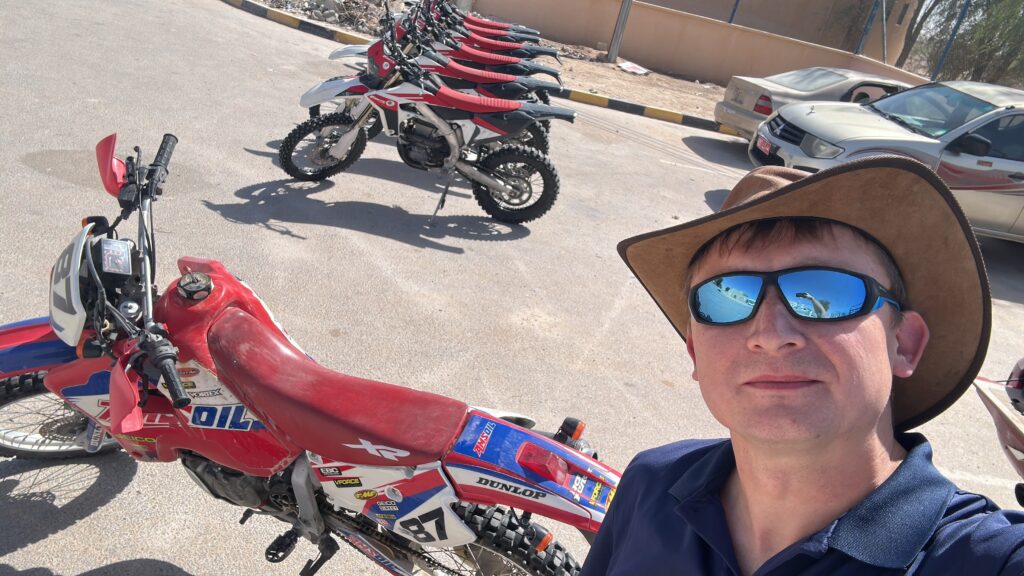
The guys have arrived and we were ready to go. The journey started really flat with good speeds and occasional breaks.

The bike was behaving well, however not without a few stalls. For those unfamiliar with this old technology, when you start this particular model of Honda during every kick start you have to do everything right otherwise she will continue to say no. Actually XR650R is a bitch in getting her started – there is a whole procedure to wake her up – miss one step and she will always say no. Later on I realised it had another problem with it, but more about it down the line.

As we rode, and me having occasionally to get it started, I was getting more and more tired. What really got me was low speed and high temperature (it was around 37 degC at that point) and we could not get enough speed to cool off as we were going through the Wadi – the terrain was bushy with plenty of ups and downs. I was heating up.
As we were going through a desert-Wadi the scenery was really nice. At some point the guys stopped to ‚talk to camels’. With experience of having to start her a few times on the way, I decided to keep small rpms as they were taking pictures with the animals. At that tranquil moment, while seating and with legs on the ground the coolant balancing tank… suddenly exploded! BAM! Half of my leg was protected by the boots, but unfortunately the upper part got sprayed with boiling coolant.

I don’t think there was much pressure that got the tank to explode, but rather it was due to a high temperature in combination with old plastic – the bike at the end had 23 years and who knows what kind of sun exposure it experienced, especially here in the Middle East. In the photo below you can clearly see the crack structure on the plastic suggesting material embrittlement.
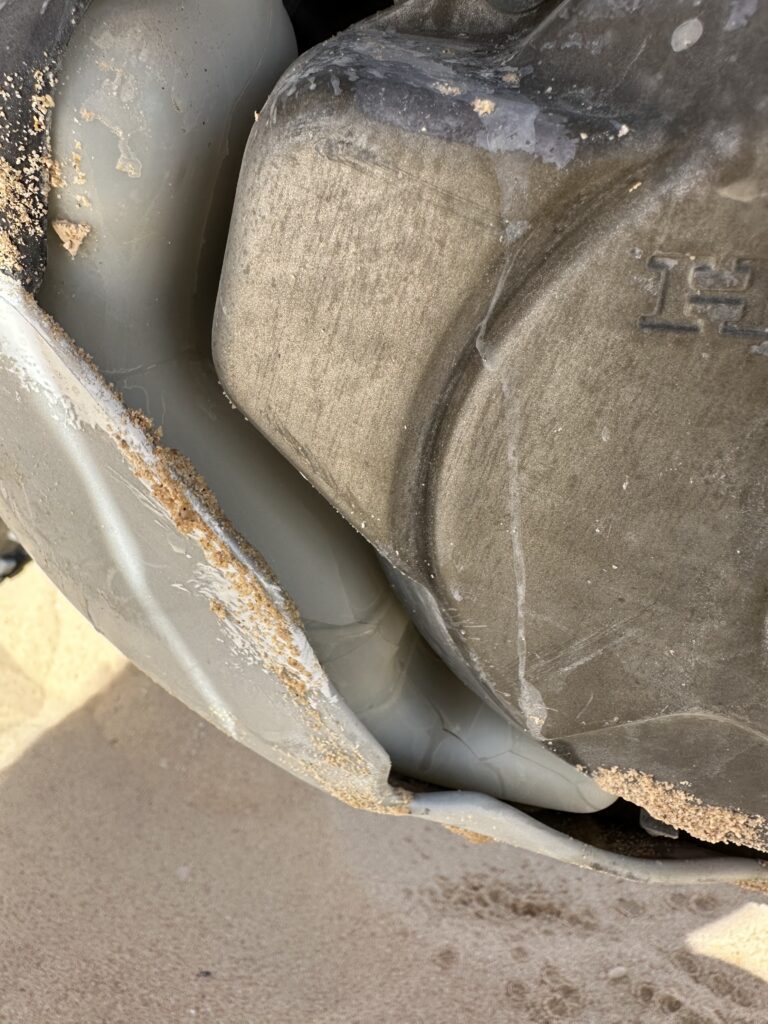
The burn was not that deep, but at that point I thought it was the bike that would get me immobilised – I thought my engine cooling is gone.

Thankfully, we had Franco Picco with us who having attended 30 Dakar races has a very high threshold before giving up. He studied the system briefly looked at the cracked tank and said: “you don’t need that”. So together with Vittorio they patched it with duct tape and I was back on seat.

As they patched it – although nothing special you would have thought – you could see that every move was carefully planned and done with utmost attention to detail with no hurry and full precision. Mastery comes from practice and for Franco who has been breaking and repairing his bikes for almost 40 years this was a first demonstration of his craft (more about it later).
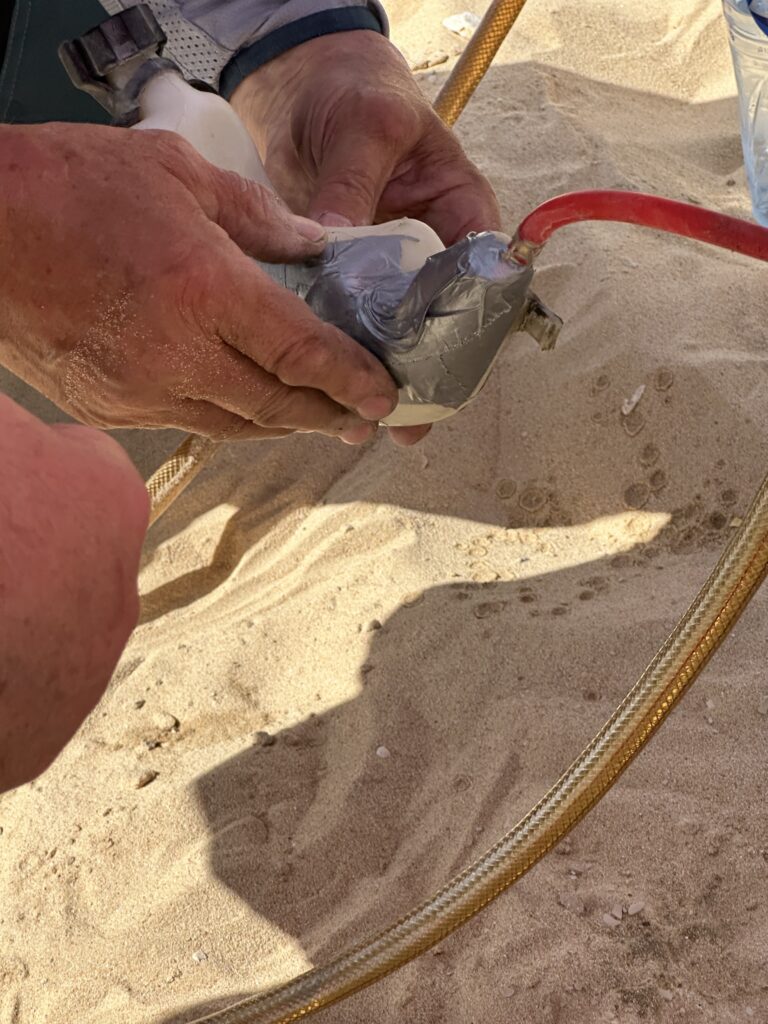
The repair gave me a moment to take a breath, however the heat was immense and I felt my body was overheating…


We continued through the Wadi with some 4.5 hours behind us and with occasional bike stalls – I had a feeling that for every next kickstart the bike was getting more and more difficult to start. At around 16:30, after another stall, I fell on the ground. My body was overheating, I was exhausted and the bike wouldn’t start. This was the moment I had to decide: do I continue or jump on the car and leave the bike behind. Waiting for the body to cool off was not an option as I would have to rest for at least 30 minutes in a shade and we had to stay as one group and they guys were already ahead.
The decision was simple: if I continued I would faint, so I left the bike and jumped in the car.

Thankfully, we were some 5km from the camp location for the night where I could rest properly and think about the options for next day.


What got me was the combination of heat (going through Wadi at 37 degC with low speeds) and tiredness from having to kickstart the bike so many times. The burn on the leg was not a factor I think, but certainly added to the overall mental state.
So never give up – but sometimes you have to – knowing that point given your limits is what separates those who make it from those who don’t I think…
After a good night sleep, next morning we turned back and I picked up the bike and we started Day 2. I was back in the game.

… But learn when to say no
Not long after the second day started I had to test my threshold again. This time, however, it was not about my strength but my skills. As we continued inland, the dunes were getting bigger and bigger – some of them up to 350m high.


As the dunes were getting bigger it was also more difficult to find a path through them (making it more fun and exciting of course).

As it can be seen on the satellite map riding in the Empty Quarter is a combination of dunes crossing and flat sections in between. This makes is ideal as you do workout on the dunes, but then go down and have longer flat sections to rest and cool off before jumping on the dunes again.

During one of those crossings – on Day 2 – we reached a point where my skills were put to a test. With not so many options we found one passage at the top of the dune, the cars were a bit slow, so I passed by them to reach the dune’s crest first. When I reached the crest and looked down, it was so steep that I could not see the lower part of the hill.

It was a double angled slope with only top half visible from where I was standing. The lower half could be slightly more steep or just a vertical wall – I could not see it. Below is the video from that point albeit not fully reflecting its steepness.
Going down there was simply beyond my skill level and I told the guys: I am not doing it – can we find an alternative route? Thankfully, Mario joined me and we both were led by Franco via other side of the dune. The go around was not easy at all – actually cars wouldn’t be able to make it as the dune had too steep slopes. Actually, it turned out that this alternative included the toughest recovery of the entire trip for me.
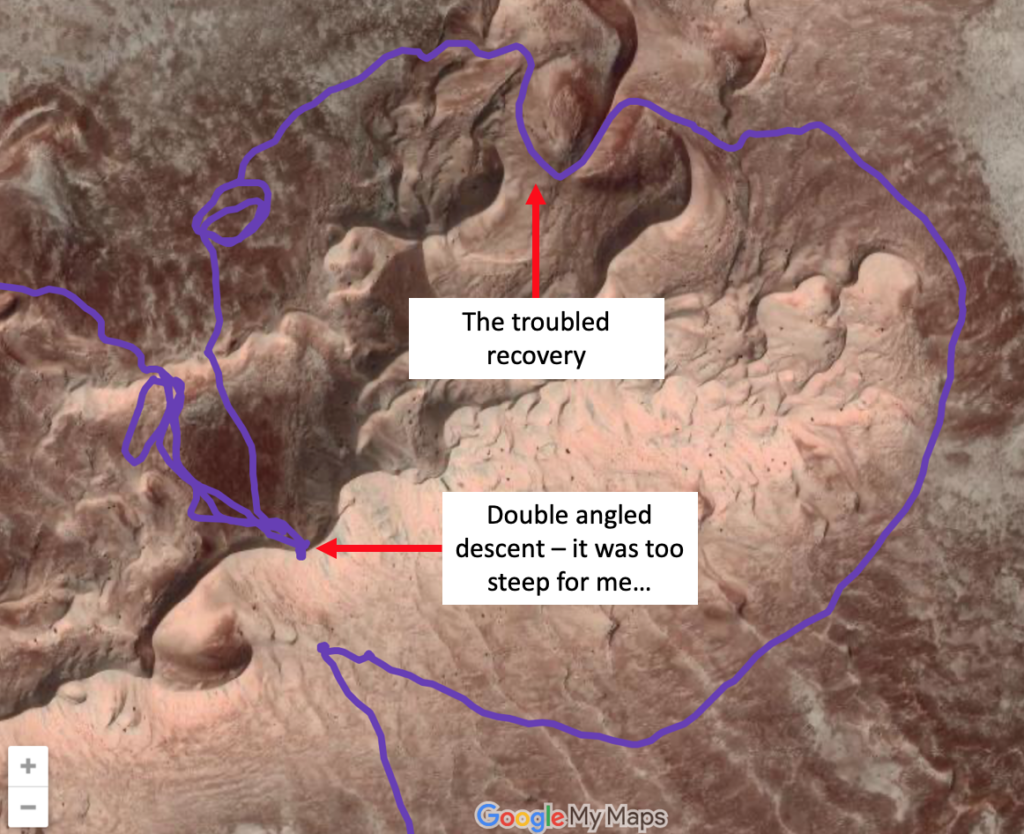
We turned back down, took right, went around and soon entered a very long slope exit from which it was only possible to go via a narrow crest of the connecting dune. To make it more exciting, on both sides of the crest there were two pretty big holes – or bowls as people call them. Going down in one of them would not be the end of the world, but it would take extra time and drain more energy.
Off I went. At the beginning it was smooth with good momentum and speed on the slope, but towards the end I had to slow down to take a 90-degree turn to skip on the crest of the perpendicular dune. Unfortunately, as I was approaching that point the sand got softer and I closed the throttle a bit too early. The front wheel quickly sacked in and the bike stalled. Normally, nothing to worry about, but here I was at a pretty steep slope with quite some meters to do before reaching the crest and every turn of the wheel was pulling the bike down into the hole and not forward.
This meant dabbing with legs while slowly trying to spin the back wheel to reach the crest. After quite some effort I made it without going into the hole – I was so pleased with myself.
Mario who was going behind me dropped the bike too, but was too far from the crest so had go down in the hole and recover from there.

and trust what you know
That recovery was one of the toughest things I’ve had to deal with and afterwards I was completely done for the day.

Thankfully, we had only some 20km left for the day, so soon I had a chance to rest.


Never give up, but learn when to say no.
Franco Picco

My encounter with Franco Picco was a complete surprise and honestly, before the trip I didn’t even know who he was.
The night before the start of the trip Yousuf called me that the bikers will be led by Franco – the Dakar legend who attended 30 Dakar races. I wasn’t sure whether I should be happy or scared given my relatively small experience.
You could write a book (actually one was just published – unfortunately in Italian only) about Franco’s motorcycling career, so whatever I say about his past achievements won’t do the justice. So I won’t. I will only say he did 30 Dakar races as a racer and lead mechanic, is now 68 and still very young. I would rather focus on a few points I personally picked up from interacting with Franco over the 6 days of our trip.
It is about wisdom not faith
I remember one interview with Johnny Campbell (11-time winner of the Baja 1000 – the high speed enduro race) when he was asked: aren’t you worried what’s gonna happen at those speeds and what you are doing is dangerous? He then responded “no I am not afraid, I am holding to my faith that is the insurance policy I have”. For him dying is just a step before he gets home like he calls it. That lack of fear is what I think got him to take the risks that others wouldn’t. Eventually racing at 160 km/h through a desert like they do at Baja has to take some faith – one mistake, one rock and a second later you are gone. And many did.
What I learned from Franco is more relying on wisdom than faith. Don’t get me wrong, it’s not about comparing, but rather about a different view on risk. One of the evenings we had a longer conversation about my skills and the bike and Franco said that for him the most important thing is that we are all safe. Later on when I watched him and we talked some more it became clear that it is about a threshold each of us have and staying within it is what makes you to be in control. And that’s what you want riding a bike – taking risks, but be in control and not doing things that are just based on leap of faith.
Another example of this approach, was Franco’s constant review of the scenarios and options we had given the problems with the bikes. He was always 2-3 steps ahead in “what if” planning. If this clutch can’t be repaired, we swap these bikes, take this route go and pick up the flooded bike and repair it before returning to main route – was one example. Another time, when changing the clutch, it so happened that he had a spare magnetic screw in his bag to replace the old one in case there were any metal particles from the worn plates.
Master your craft
Whatever you do master your profession before teaching others. Franco spent some 40 years riding bikes in all sorts of conditions and races. This involved not only knowing how to ride, but also how to navigate and repair your bike. Even with so much experience behind his belt, every time there was an issue with any of the bikes he was the first one to address the problem regardless of how big or small it was. He could have easily give it others, but no, he always was there to do it himself. Whatever advice he gave us, be it about riding or the bikes, it was always backed up with a simple explanation about why is that. For example, why it was ok for me to continue using the bike when the cooling tank exploded or when I flooded the air intake with oil when the bike flipped upside down on a side of a dune. Or another time when we couldn’t suck out fuel from the barrel. No matter what we did we could not get the fuel running down the hose. To our surprise Franco put water into the hose to create suction by the draining water head to pull the gasoline out. It worked.

Many people, especially the younger generation, jump around seeking constant progression without mastering the fundamentals. But when things are getting tough or require non standard application of they know, they struggle.
The real growth comes from mastery.
Sometimes to succeed you just need a bit of luck
There are many skilled people out there but not all of them succeed. Motorsport career is a risky business – you may be lucky that you meet a sponsor who will want to put money into you, but you may also die trying no matter how talented you are. That’s the response Franco gave me during our lunch stop breaks when I asked him about any tips for someone entering Motorsport career (asked for a friend 😉 ).

To stay young keep doing things that make you young
Your mind follows body mind (not other way around!) – smile and you become more happy – try it. You can hear many older guys out there – „I am selling my bike, I am too old and fat now” and they haven’t even reached their 50-ties. Franco is 68 and fully into desert riding, maybe not in a race, but I am sure he would have kicked many asses out there. It was inspiring to see him doing all the stuff on the dunes and for me it got me thinking about how much we limit ourselves following our expectations. If you say to yourself your are old and fat that’s exactly how you will feel and behave. So be careful what you think of yourself as that’s what you will become. If you want to stay young do things that keep you young.
Great lessons from Franco – so lucky to have met him.
Flora and fauna
There are not many forms of life out there – it is a desert eventually – but what exists there makes you wonder how anything could survive in such harsh conditions.
It seems to be about the energy use – those that use in most efficient way survive.


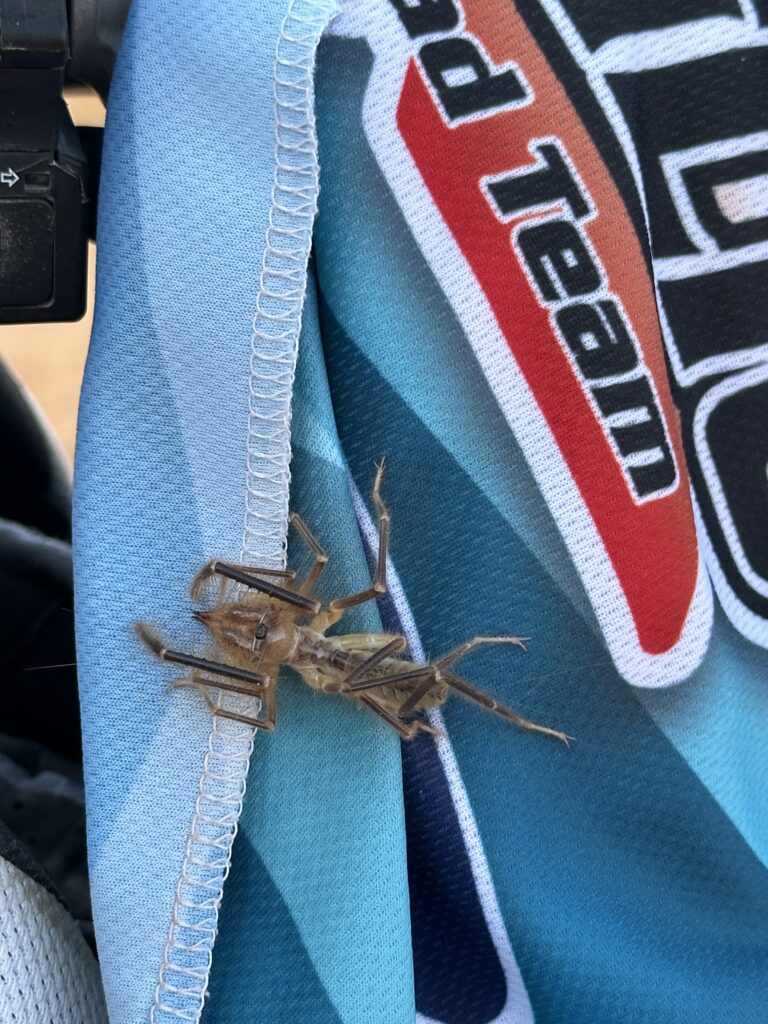


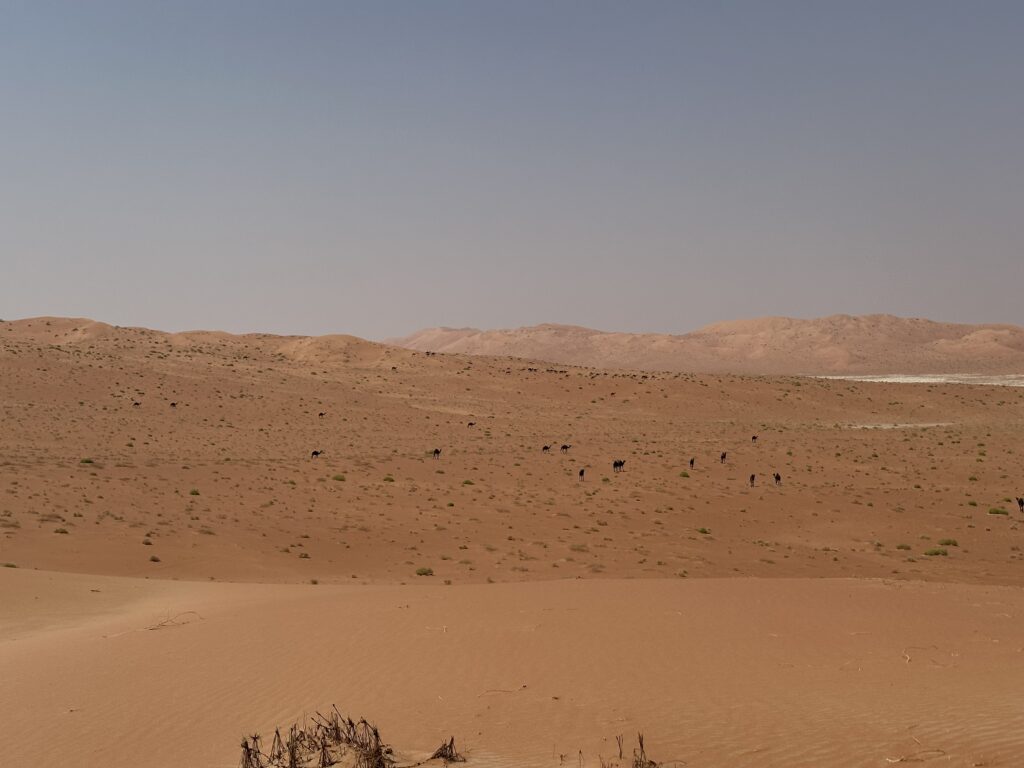
The camels are owned by different tribes. I was surprised to see so many cars on the road to Ubar with Emirati plates – later on I learned that some of those tribes are actually from the UAE (more on tribes in section below).

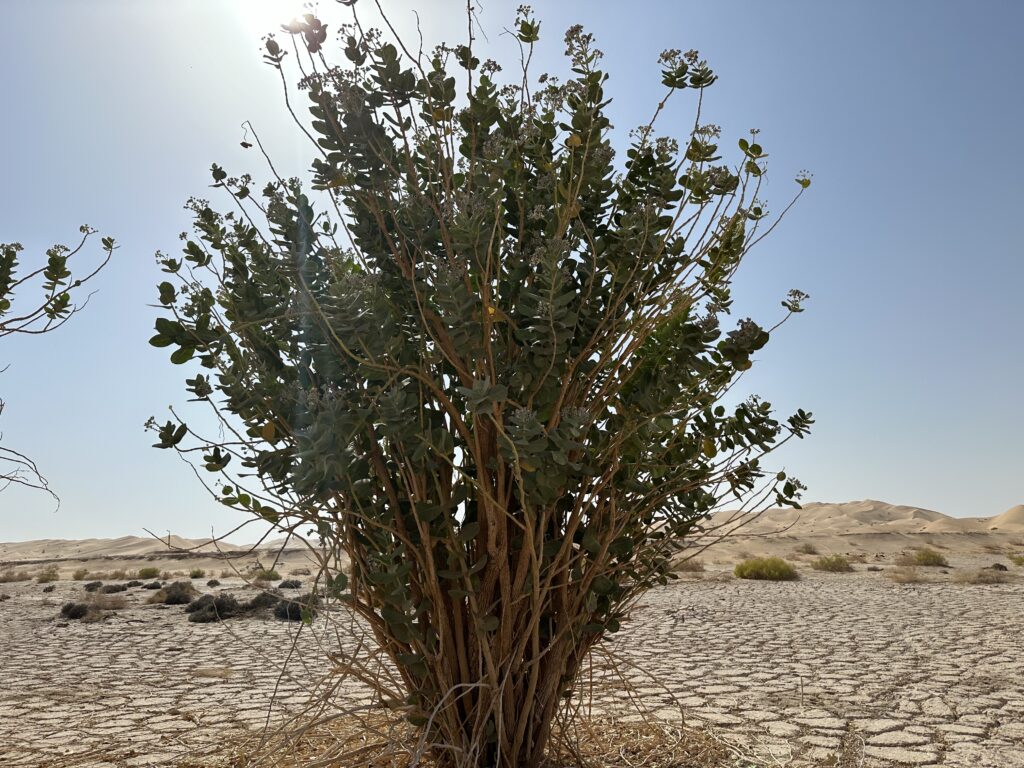
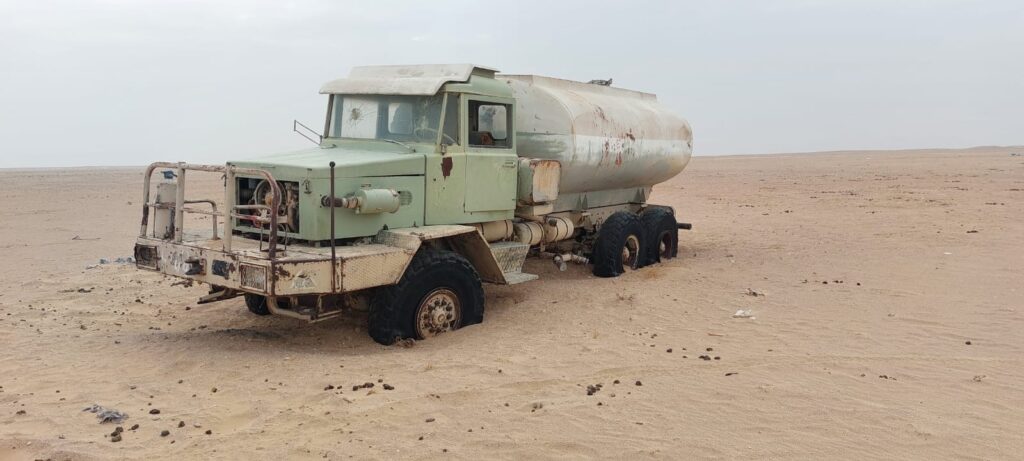
Bikes… and their maintenance
Nothing major really, but it wasn’t without some minor jobs on the bikes. It is important to be prepared and have necessary tools and spare parts with you.






The XR650R… and its problems
Most of my struggle with the XR650R was due to my own incompetence, be it missing the piston’s top dead center while kicking, using choke when not needed or simply trying to start it with no fuel. Putting that aside there are two complains I have about my particular bike:
- It dies off after some 1 hour running hot – after the bike gets into the temperature the moment I close the throttle the engine stops. This is not a problem when the bike is cold with nice idling rpms. After the trip Franco tuned up my carburettor, but still when I took the bike for a ride the problem returned so I gave up and now the bike is at the mechanic trying to figure out what is the issue. Having read what is online it seems I am not the only one who has this problem and people trace it back to weak electric stator that after reaching certain temperature is not giving enough voltage for the spark plug. Once I find the cause I will update what was the issue.
2. Air filter passes fine sand – even after putting silicon around the metal strainer and having the foam filter the sand continued to enter the air side. I can say I was lucky that I flooded the bike with oil as this prevented sand ingress and complete engine damage as it happened earlier with my friend’s bike. Later on I discovered that the oil drain outlet should have been plugged! I think this could be the main reason the bike sucks sand – learning every day.

The main reason, however, at the time that I had to change to a spare bike was when it got upside down as I dog in with a wheel on one of the slopes. What happened – as Franco explained to me later – was that crankcase oil breathing line from the engine is connected to the air intake (as the air inside the engine expands, its excess is send for combustion though the air filter).
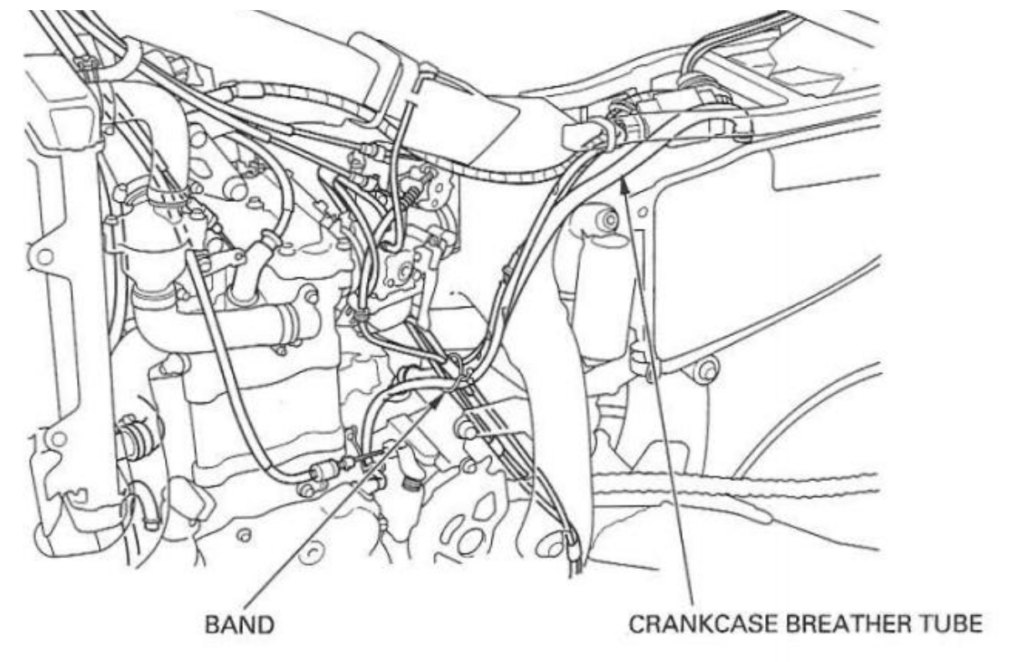
Bike flooding was not immobilizing the bike itself – possibly I could kick it through – but it was my incompetence when I saw oil on the ground thinking some of the engine gaskets is gone.
Overall, I loved the bike and will continue to use it even though it teaches you the hard way.
The Oasis
Some 110 km from Ubar into the desert there is one and only Oasis in the Empty Quarter. Here is its exact location: https://maps.app.goo.gl/oavEDwJ1SG7A1RJDA
The reason it exists there are three water wells called Burkana-1 that are flowing and water the trees. The trees have been planted some 7 years ago I was told. It is one of those fast growing ones. This was an ideal place for the rest – you could take shower or have a swim in a small pool. The H2S that is present in the water (next time I am taking my gas detector with me!) was not the main concern preventing me from entering the pool, but rather the fact that I had an open wound and wasn’t sure how all the chemicals in this water would react with my blood. The water is certainly saturated with all kinds of elements as it leaves grey marks on the ground (see photos below) but people say it is good for your skin.






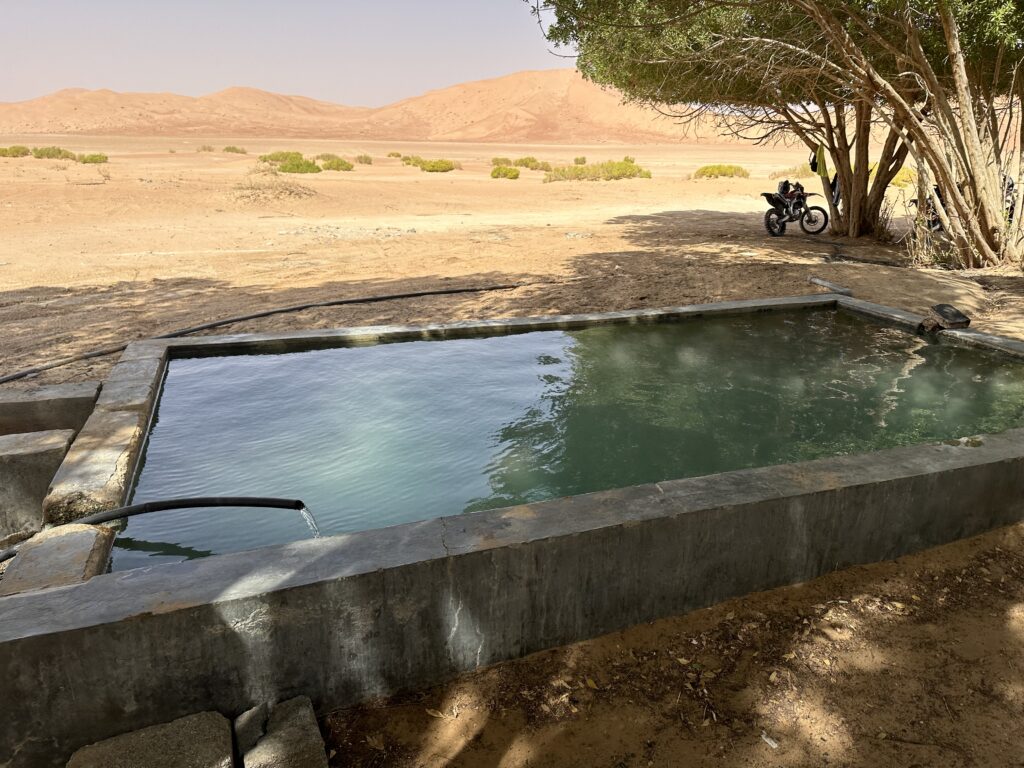

On the way back we shared some food with Indians who got stranded there as their truck broke down and were waiting for rescue by their employer. Apparently, there is some construction going on down there.

Reaching the Oasis at Burkana 1 by road on a bike can be dangerous due to long sections with a very fine powder. Yousuf mentioned two guys broke their shoulder bones this season there. The dust is so fine and deep that no matter the speed you have, you dig in. The reason it is dangerous is that it looks like a solid ground but behaves like soft mud. I learned later on that this kind of ground has its own technical name: Fech fech (or fesh fesh) and it is well know among offroad racers.

Bedouins and tribes
We did not meet many people out there, but those single encounters got me really interested in the tribes who occupied the Empty Quarter now and in the past. For those interested in learning more about those tribes and their life before the ‘oil era’ I highly recommend the 1959 book of Wilfred Thesiger “Arabian Sands” where he describes his 5 years (1945-50) spent with Bedu tribes in and around the Empty Quarter. He was also the first Western explorer to cross the Rub Al Khali desert on a camel – really fascinating stories in that book. Also you can find pictures from his first expedition here: https://web.prm.ox.ac.uk/thesiger/index.php/thesigers-journeys/11-thesigers-journeys-in-arabia-first-empty-quarter-crossing-1946-7.html

And then https://prm.ox.ac.uk/collections-online#/item/prm-object-341185
Food
I find food to be a super important part of any trip experience and during this trip it was just amazing. As we were with folks from Italy we ate Italian food most of the time, but we also had some Omani flavours. The trip was full-board, so the only thing we had to worry about is to keep riding and putting on our tent when done for the day. Every single meal was prepared and we did not have to worry about anything. Really nice and convenient, especially after being wasted at the end of the day. I really liked the call of Yousuf in the morning: wake up the breakfast is ready:)






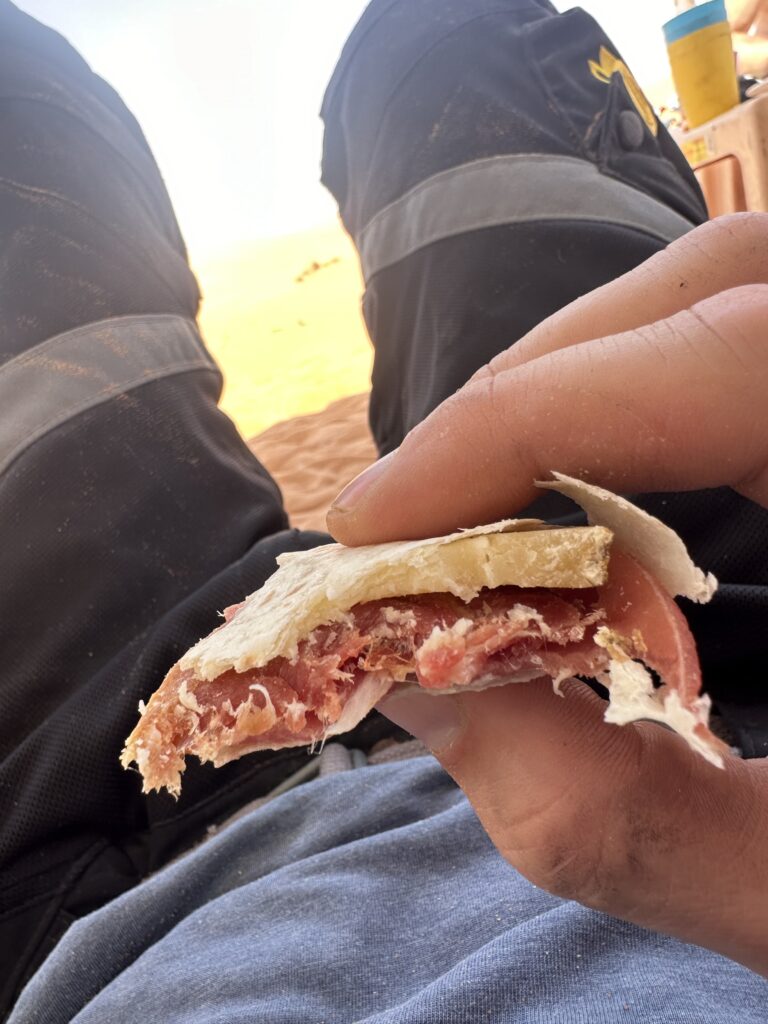








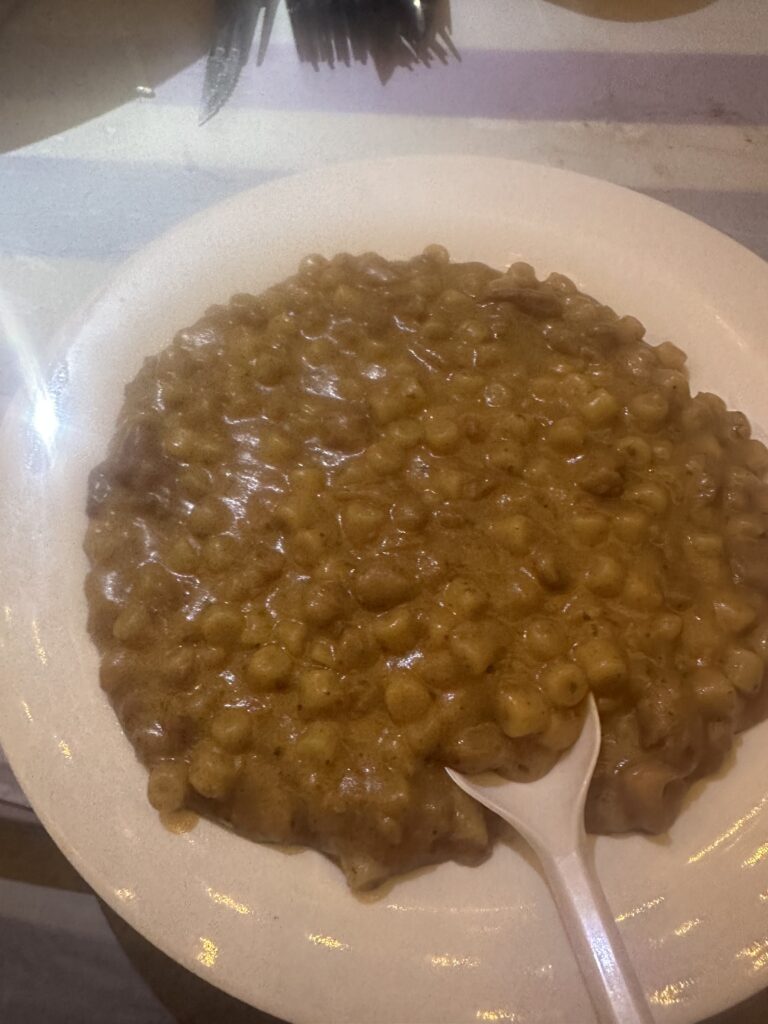


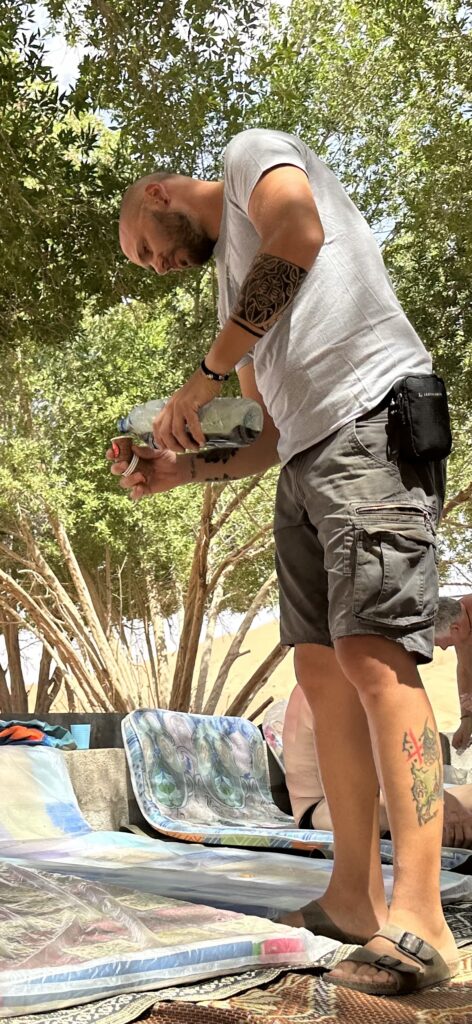




The End
what an adventure! Can’t wait to embark on the next one 🙂


4 responses to “The Empty Quarter on a dirt bike”
Hey Lukas,
You have me sold on this trip and I’d want to try and follow Franco up those dunes. It was great to ride with you and the guys last Friday. A great write up mate!
Hi Lukasz, it is really great trip and I think you will have memories for life from it 🙂 I spend nice time reading it, very good writing skills. Enjoy!
Great adventure, good reportage and nice sunsets over the desert 👍
Waw incredible trip have seen in my life .